Published 6 October 2022
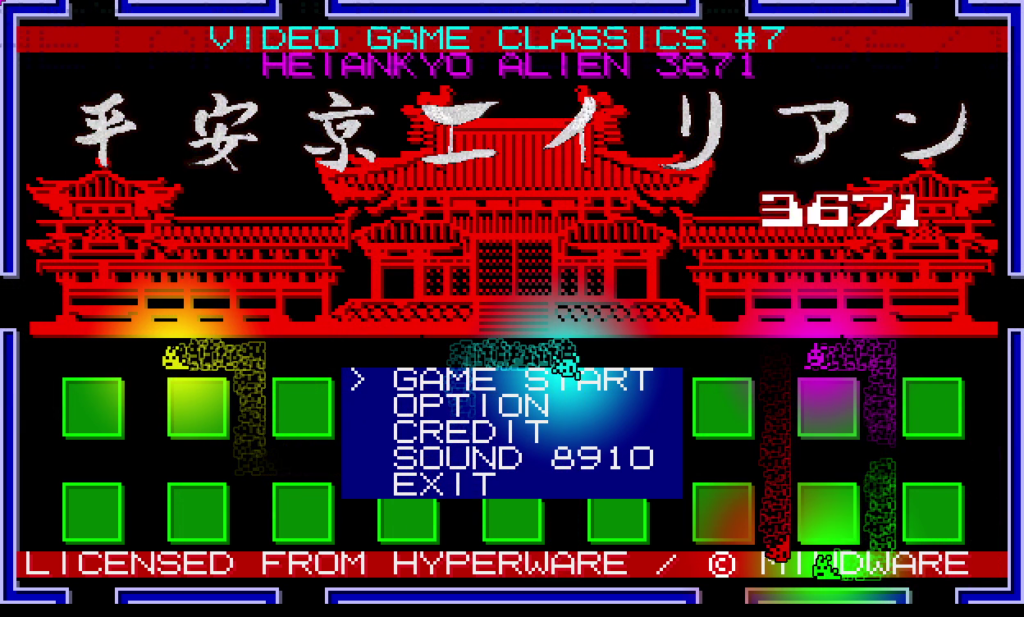
Little-known save to those in certain gaming circles and to Jeremy Parish fans, the 1979 video game Heiankyo Alien, developed by the University of Tokyo’s Theoretical Science Group, is significant to video game history. It is an early if not the earliest maze chase game of the model Iwatani Toru would more famously explore in Pac-Man the next year. 2017 saw two sequels, the Famicom-exclusive Heiankyo Alien NEO as well as the subject of my review: the frenetic sensory explosion Heiankyo Alien 3671. As part of Mindware’s DIG DIG DIG series of early video game rejiggerings, Heiankyo Alien 3671 is to the 1979 original what Pac-Man Championship Edition is to Pac-Man. How well does 3671 succeed?
Technically, Mindware’s release is simply called Heiankyo Alien and 3671 is just the primary game mode. To distinguish it from other releases, I will call the overall release Heiankyo Alien 3671.
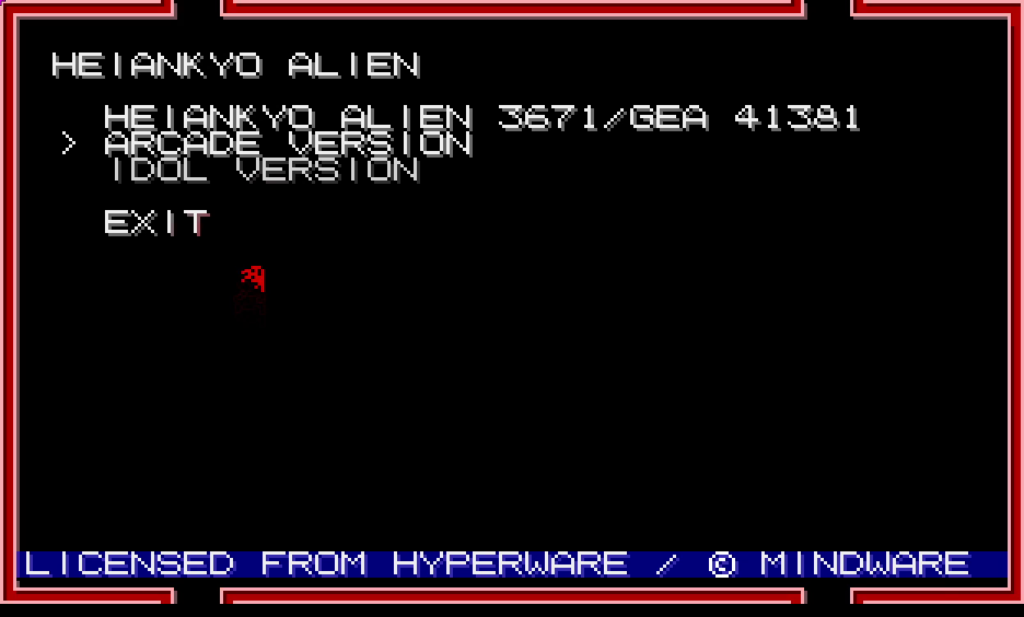
The main menu includes three options: Heiankyo Alien 3671/GEA 41381, Arcade Version, and Idol Version. The first is self-explanatory. The Arcade Version is an emulation of the 1979 original. Idol Version is apparently a planned full game mode in collaboration with the idol group Guildoll, ambitiously involving full voice acting and unique missions. Ironically, the store page misspells the name as “Idle Version,” summing up the current situation. As of October 2022, selecting Idol Version only triggers a J-pop song to play. While the peppy beat continues if the player selects Arcade Version, the song fades out after a little while. So unfortunately, it may not be possible to play a whole round of the mostly silent arcade original with (what I assume is) Guildoll singing in your ears. This song cuts out instantly if 3671 is selected.
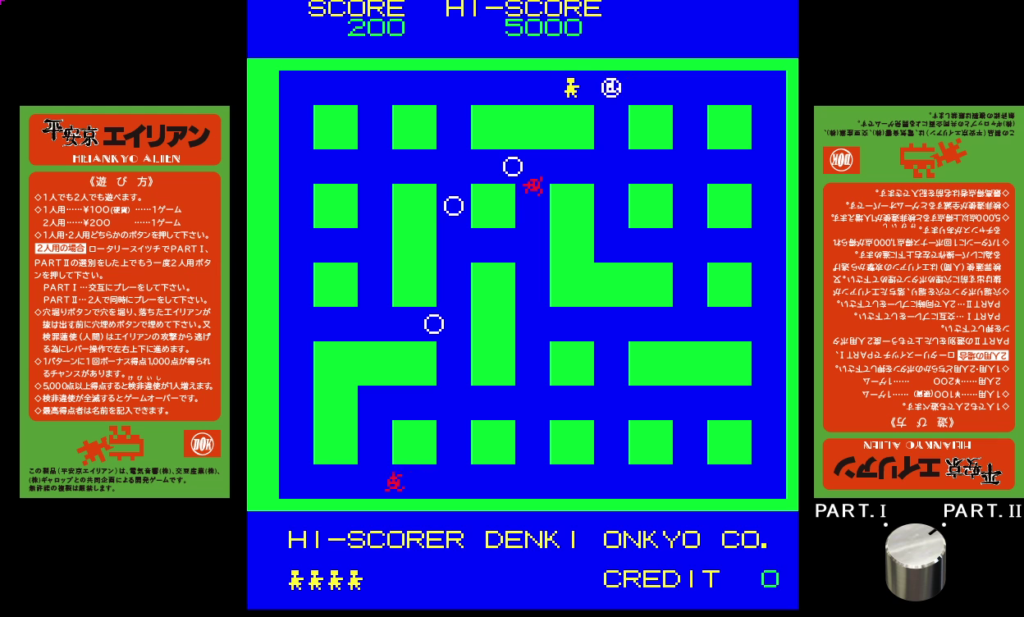
In the original Heiankyo Alien, the minimalist pixels allegedly depict a policeman (kebiishi) in Heiankyo, a former name of Kyoto, battling an alien invasion with a shovel. Navigating a maze of medieval city streets, the player rapidly taps one of the two buttons to dig a hole and the other to fill it in. The goal of each stage is to eliminate all the aliens by waiting until they fall into the holes and then burying them alive—one of the most brutal ways of killing. I would think the policeman could slice them with a sword, but perhaps all the swords are currently being used to put down the Hōgen rebellion or something. The aliens wander the maze seemingly at random. Touching an alien causes it to devour the policeman, costing a life. The gameplay is slow and the digging agonizing. The invisible timer counting down to a high-speed alien swarm spawning to devour the policeman’s remaining lives brings the tedium to a cruel end. Some players find this compelling, but I never figured out a strategy.
Like Pac-Man Championship Edition, Heiankyo Alien 3671 boosts the speed of its progenitor. But the original Pac-Man already becomes fast-paced a few rounds in. The effect applied to the crawl of Heiankyo Alien produces an even fresher experience. Championship Edition is intuitive: eat all the dots on one side, grab the fruit, eat all the dots on the other side, grab the fruit, etc. until the clock runs out. Each round of Heiankyo Alien 3671, however, follows an obscurer rhythm. The developers at Mindware know it, too, pleading with the player to read the instruction PDF and also the guides in the Steam community “in order to taste the tremendous uplifting feeling of killing aliens furiously.” Your head will be spinning by the time you finish reading my description of what Mikito Ichikawa set up in 3671.
3671 is the pursuit of high scores, but there is no in-game scoreboard or other method of tracking them. I believe my current high score is around 2,400,000, but I am not certain—what a weird design choice (what is this, Rooftop Cop?).

The layout of the rudimentary maze varies each round. A timer in the center counts down five minutes to set a swift pace, similar to Pac-Man Championship Edition. The time running out is the only way to get a game over. The policeman spawns in the upper left corner. If the player is starting on level 1, a flying saucer drops off five aliens, red, yellow, purple, blue, and green, and more if starting on higher levels. By default, there is at least one exit on both the top and bottom or left and right of the maze looping into each other, like the side passageways in Pac-Man except that the aliens cannot use them.
In the original arcade game, digging holes is a slog—just like in real life. 3671 sets faster baseline walking and digging speeds and accelerates both from there. A hole partially dug temporarily stuns any alien that touches it and provides a chance to run through the invader unscathed. After an alien falls in a fully open hole, it begins shrieking. The player should then bury it for 100 points, removing it from the maze. If too much time passes, instead the alien will escape the hole, filling the trap in on its way out. If another alien touches an alien trapped in a hole, it will free its companion, causing the hole to instantly vanish. Overestimating the amount of time remaining before the alien escapes the pit has cost me many lives. So far, this description of the gameplay constitutes little more than a speedier version of the 1979 foundation. However, 3671 quickly diverges.
In 1979, the goal of each level is to remove all the aliens. But in 3671, the goal is high, high, high scores, scores so high that the oxygen thins. So each alien buried spawns at least one replacement alien. Every two aliens buried raises the current level. It also adds a multiplier to the score, ×1 for the first level increase (100 points is 100 points), ×2 for the second (100 points is 200 points), maxing out at a ×9 multiplier (100 points is 900 points). The level itself will increase as high as the player can get it. Every five levels gained increases digging and movement speed. The penalty for being eaten by an alien is not the end of your existence, like in real life, but time, as the death animation occupies a few seconds before the policeman, slowed, respawns and, more devastating, the score multiplier resets to ×1. A moment of silence in honor of the deceased score multipliers.
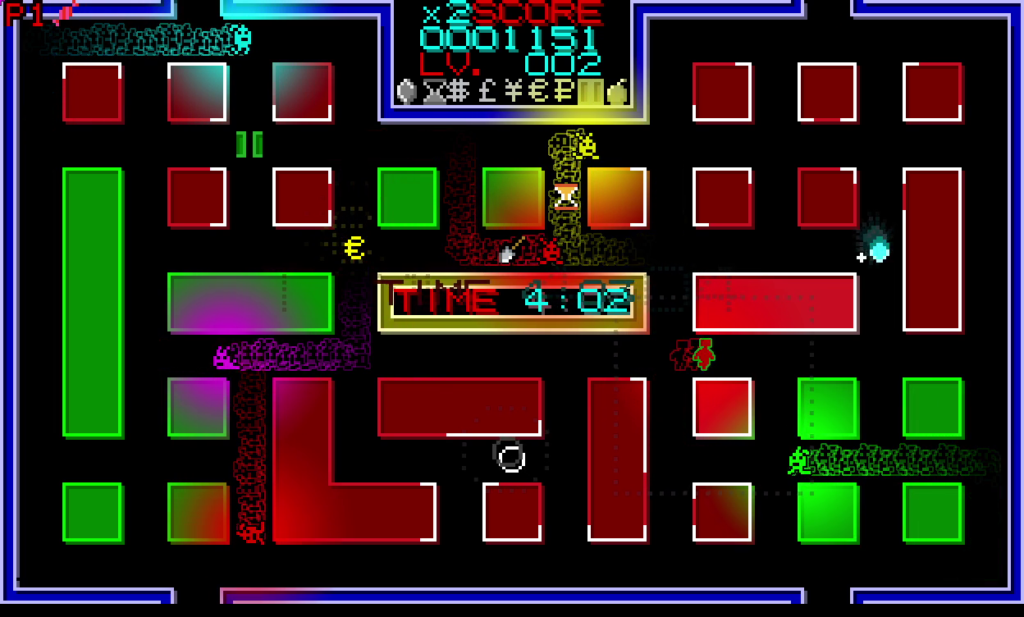
As best I can tell, unlike Inky, Pinky, Blinky, and Clyde, the aliens of 3671 all behave the same, running around at random, turning around when they bump into each other, and chewing up any human they might meet. Burying multiple aliens of the same color in a row yields bonuses. However, every green alien has two unique properties. When it passes over certain spots, a green alien emits a distinct noise and flashes a circle of pixels. This indicates buried treasure. More on that below. In addition, the interior structures of the maze (abstracted buildings, I guess) begin green. If the player character scrambles past one, a white outline appears around the walls. A structure completely circled in this way turns red and yields some points, varying depending on the shape of the structure. This is worth doing because every structure thus claimed offers bonus points with each level increase. Say that six squares, each worth 50 points without the multiplier, are circled in this way. That means that the next level up includes a bonus 300 points (50 × 6) before the multiplier. Running laps claim these buildings red is essential for making that number soar. The trade-off of the green aliens’ valuable radar abilities is that they also instantly revert any red building they pass to green, becoming an entropic force the player must always battle.
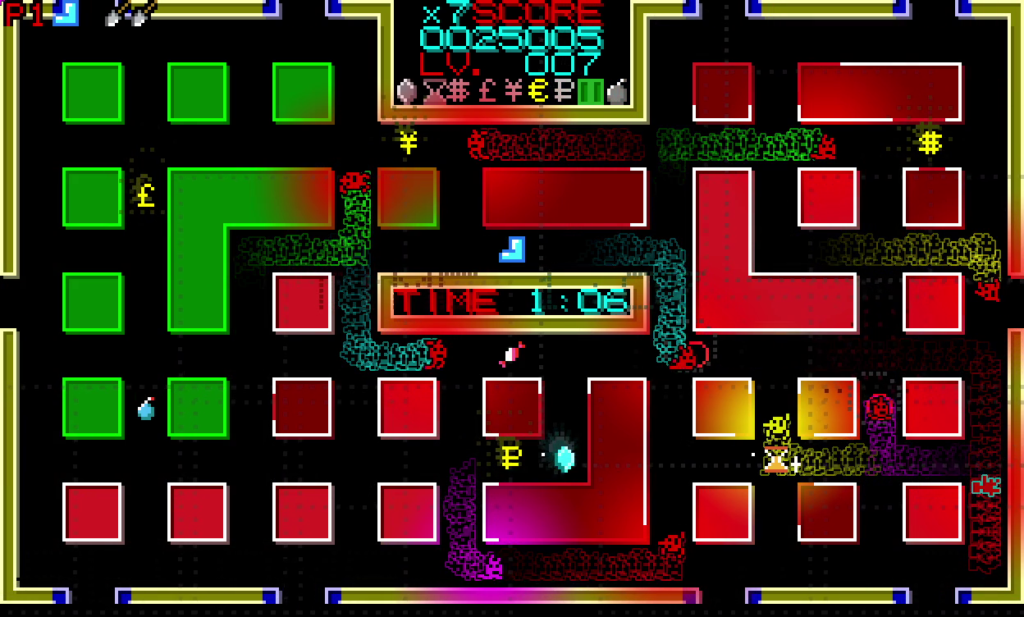
Slightly like the fruits in Pac-Man, there are several powerups that can spawn along a straight line down the center of the maze. Just to add more chaos, the instructions falsely say no more than two appear at once, even though at least four are sometimes on screen. The items include a shovel, which increases digging speed in addition to the speed increase that accompanies level increases.
Another is the blue boot, which increases walking speed to an extreme degree. While rapid movement around the maze should be beneficial, and might be to more skilled hands, in practice this speeds up the player character so much he becomes difficult to control. Holding down the bury button reduces the policeman’s speed to normal, but to me those boots are either a death sentence or a condemnation to hold down the bury button for the rest of the round. The effects of both the shovel and the boots seem to stack but are lost upon death.
The power coin, a token bearing the letter P, gives the policeman Starman-like temporary invincibility to rack up points—and the score multiplier—by ramming into aliens to eliminate them, no burying needed. When you’re eager to blast through levels, the power coin is a friend.
The heart changes the color of all aliens to red, easing the challenge of kill combos and eliminating any green aliens busy decreasing score multipliers. This could be an issue if the player hasn’t already found all the buried treasures.
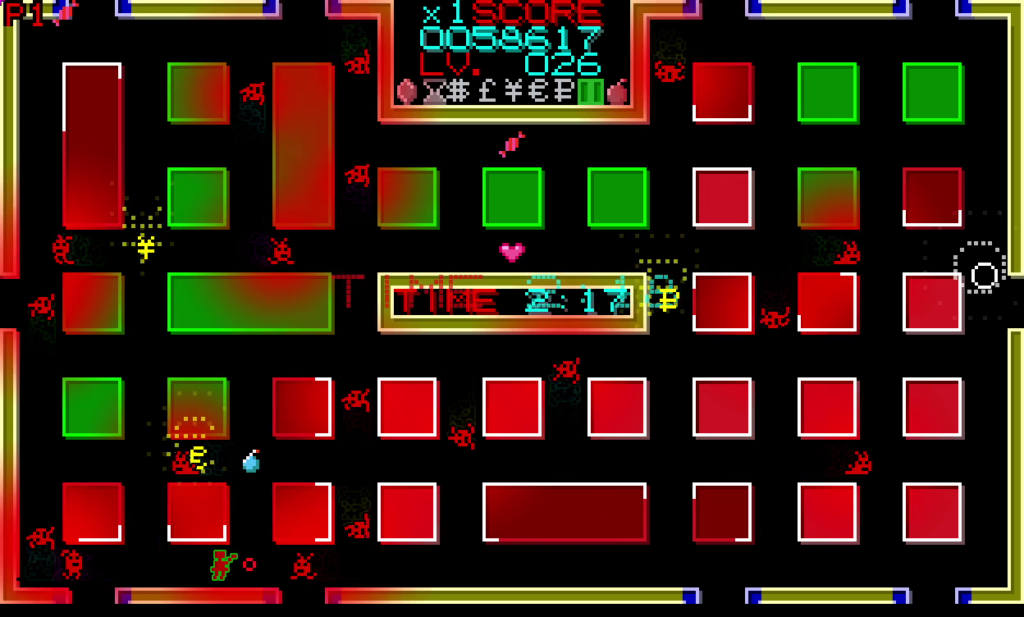
The final of these items is the candy, the aliens’ favorite treat. The player can plant a piece of candy anywhere in the maze. When an alien catches a whiff of candy, it begins singing and hops straight toward it—cute enough I almost hate to kill the monster. These treats can bait one alien at a time to either get the beast out of the way or lure it into a pit trap between it and the candy. Once an alien chews up a piece of candy, however, the sweet vanishes from the player’s inventory, like in real life except that in real life it is not aliens who eat the candy.
Though cute, the candy seems like an extraneous gimmick. Or would, if it were not for Glitch Encore Alien 41381, an esoteric mode available from the 3671 option menu. There are game modes available outside of the game mode selection menu! More chaos.
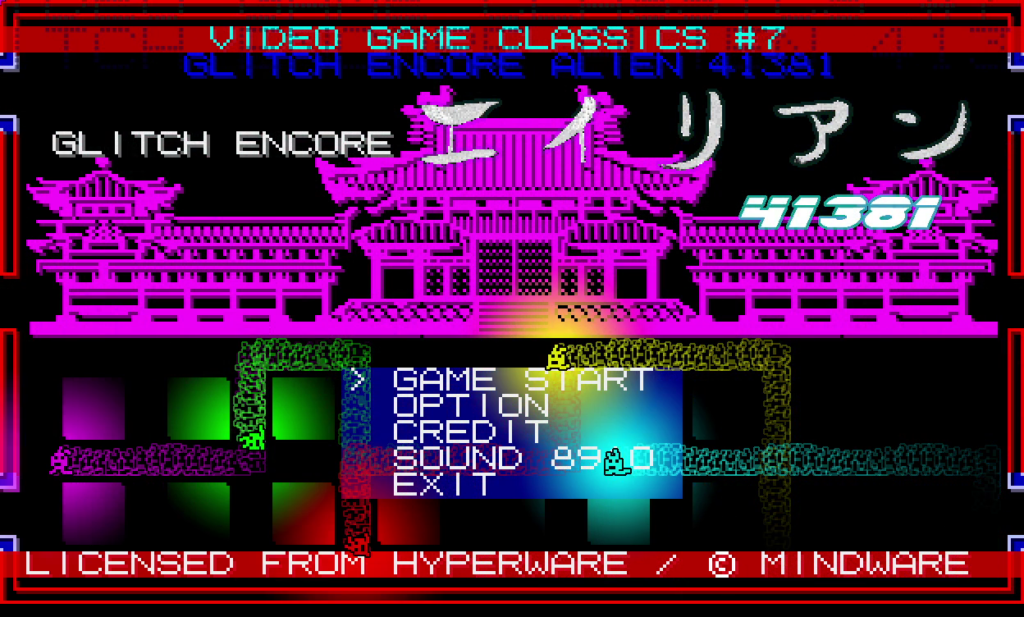
In Glitch Encore Alien and only in Glitch Encore Alien, an alien will not kill the policeman while it chews candy. This allows the player to dig a hole beneath the alien, triggering the “glitch.” This pit trap becomes a Super Hole, which emits rainbow particles, has infinite uses, and instantly kills any alien that touches it. Just two or three Super Holes around the maze result in the level blasting off high enough through the stratosphere that it might collide with the aliens’ spaceship. The maze becomes so swarmed with aliens dying every second with more reappearing that I usually end up unable to move without instant death, the colors hypnotizing me. High scores in Glitch Encore Alien need to be evaluated differently than in 3671.
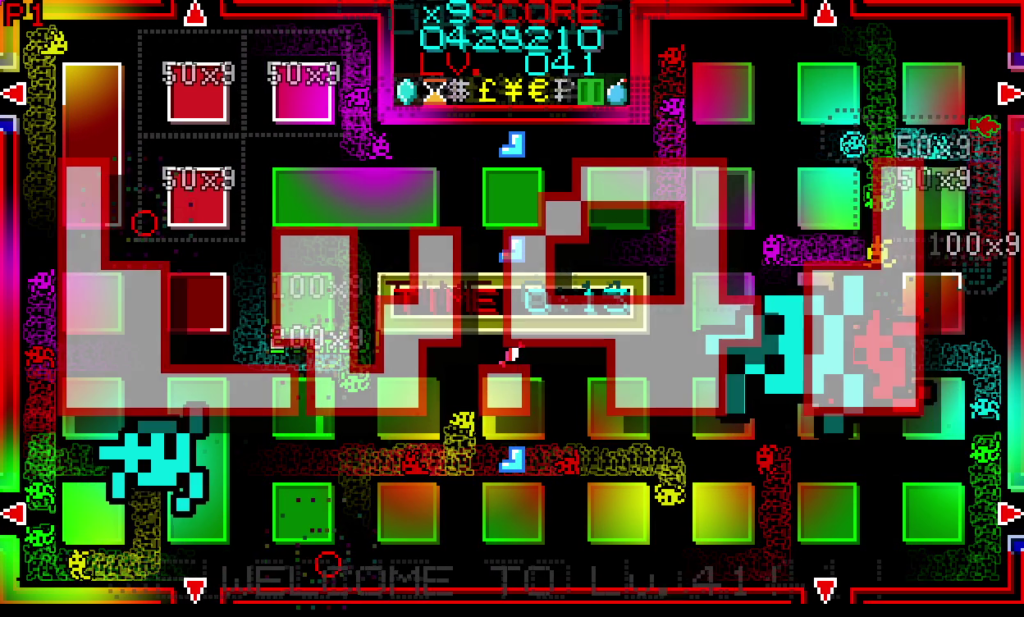
All this sounds complicated enough, but icing the 3671 cake and determining the overall pace is the pivotal collectathon element. Each round, nine treasures lay buried randomly around the maze. Or not randomly—this might be more superstition than scientific observation, but they seem to more often appear at intersections. These treasures are the diamond, hourglass, dollar sign, pound sign, yen sign, euro sign, ruble sign, double doors, and a bomb. Oddly, the instruction PDF and in-game instruction card include only seven treasures. The bomb and double doors might have been added in a later update—another element of chaos. The various monetary symbols are just points, their specific value determined by multiplying the player’s level by 100 (at level 1 each is 100 points; at level 20 each is 2000), subject also to the score multiplier. The hourglass adds ten seconds to the timer, or more, again depending on the score multiplier. The double doors yield an additional four passages to the sides of the maze, easing navigation. The bomb instantly removes every alien on screen, invaluable when the maze becomes crowded in the higher levels. The diamond is the most valuable, as it doubles the player’s score. No other item is this important. Collecting all nine treasures in a given round yields 50,000 bonus points, subject like everything else to the score multiplier, and because 3671 is feeling nice, the 50,000 applies before the overall score doubling if the player collects the diamond last.
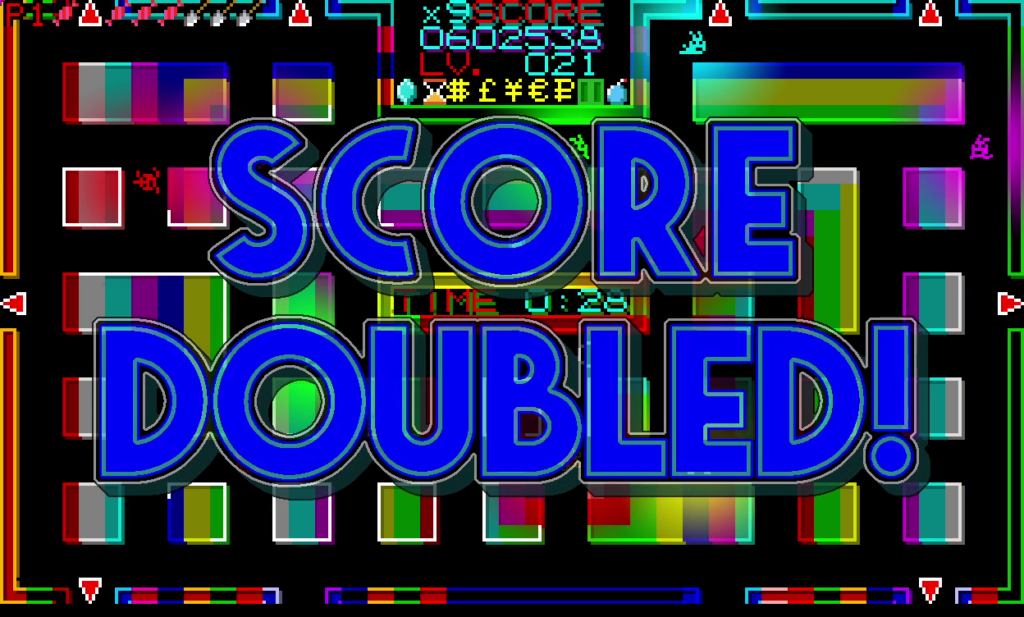
This concludes the explanation of probably the most convoluted rules I have ever seen in an arcade-style game. Please take a few deep breaths. Perhaps drink a cup of water.
3671 also features four possible pieces of background music. While minuscule beside the hefty array of the Pac-Man Championship Edition soundtrack or even the overall better and, within Famicom limitations, more technically impressive Heiankyo Alien NEO soundtrack, the hypnotic music by Wing★ and a Swedish band called Ibojima gets the juices flowing. I guess it would be considered techno. (I am the opposite of a music-knower.) According to the store page, Wing★ “admires Yuzo Koshiro as his master,” and the influence shows. Pac-Man already offered music to work with, but the composers of 3671 had to invent an aural identity for the property. After hours of gameplay, for me, the default “Sound 8910” now seems inseparable from Heiankyo Alien. “Sound IBJ1” and “Sound IBJ2,” darker and weightier (and good) tracks incongruous with the minimalist graphics, may be a bit too loud, drowning out the sound effects. The fanfare that plays upon collection of the diamond is not only loud but ignores any other sound settings the player chooses. The result was a deafening attack on my eardrums when I made the mistake of playing with no music so that I could hear a podcast.
Also noisy are the graphics by Takumi Kakiuchi, reusing the sprites from the 1979 arcade game but with trippy ghosting, flashing, hurtling particles, and text that blocks the maze to add more chaos to the 3671 brew. I prefer to play with them toned down. But even the options menu does not solve all the graphical woes—the policeman has been eaten too many times because the sprite of a new alien falling into the maze blocked my view when I needed to perform tight maneuvers. Most of the screenshots in this review feature the default settings, under which these pervasive garish effects, while they entrance and dazzle, can obscure the action and hinder the gameplay.
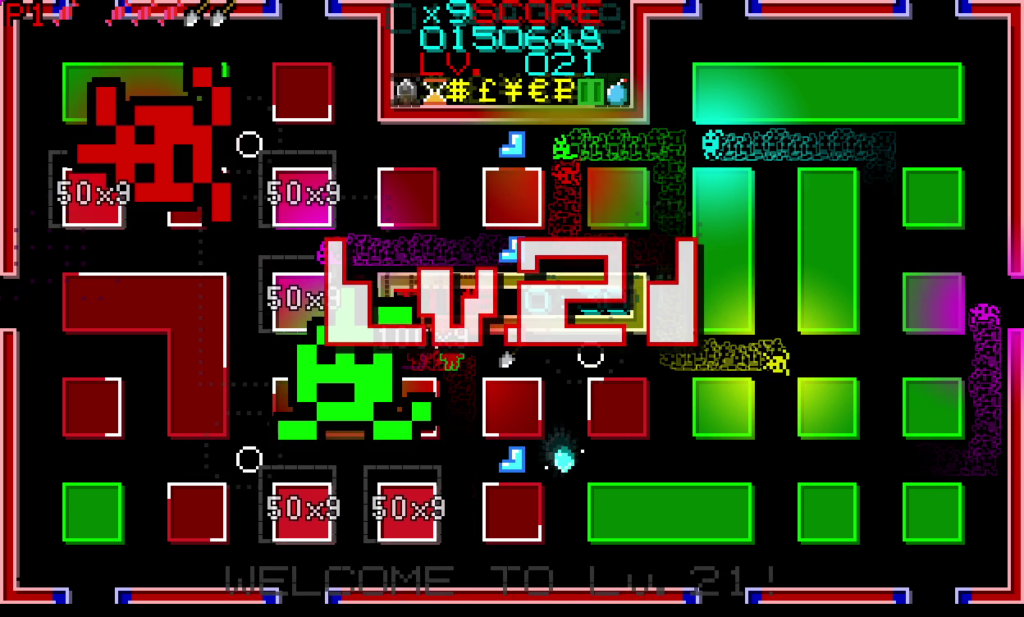
Skill at the 3671 chaos demands tactics. For it is not chaos at all but several sets of rules operating simultaneously. I usually spend the first couple minutes of a round, when the aliens are relatively few and slow, to ghost a green alien to wait for that heavenly radar sound and unearth some buried treasures. I hold off collecting the diamond and monetary symbols for as long as I can, treating them as walls blocking the road. I collect the double doors ASAP because the additional escape routes are invaluable for evading alien mouths to maintain the score multiplier and speed increases. At this point, I level up until I become fast enough to dig a hole directly in front of an alien in a second. Once I reach a ×9 multiplier, I collect the hourglass to add 90 seconds to the timer. While burying as many aliens as I can, I then (attempt to) remain near the bomb to clear the roads when the aliens’ numbers become overwhelming. The most essential part is collecting the diamond as near the end as I dare, maximizing the score. If I have held off using it, which only seems feasible if starting from level 1 (it is possible to start on level 15 or higher), the bomb is also useful for clearing the roads to allow rapid access to the diamond. The failure to nab the diamond can nullify an otherwise excellent round.
But “nullification” might be too absolute a term. The player can have fun with the peppy music, hypnotic colors, and fullest utilization of their own skill, regardless of score. This author is sure he is a dirty casual relative to whomever has set global records for 3671. What appears to be a simple arcade game conceals elaborate strategy and frenetic action and visual and aural design all geared toward instilling the state of flow, of being one with the action. A knowledge of these rules really does pay off with the “tremendous uplifting feeling” that can be attained only from “killing aliens furiously.” Pac-Man Championship Edition might be more intuitive, but Heiankyo Alien 3671 holds its own as a blast that might well appeal to those who would find the original underwhelming.
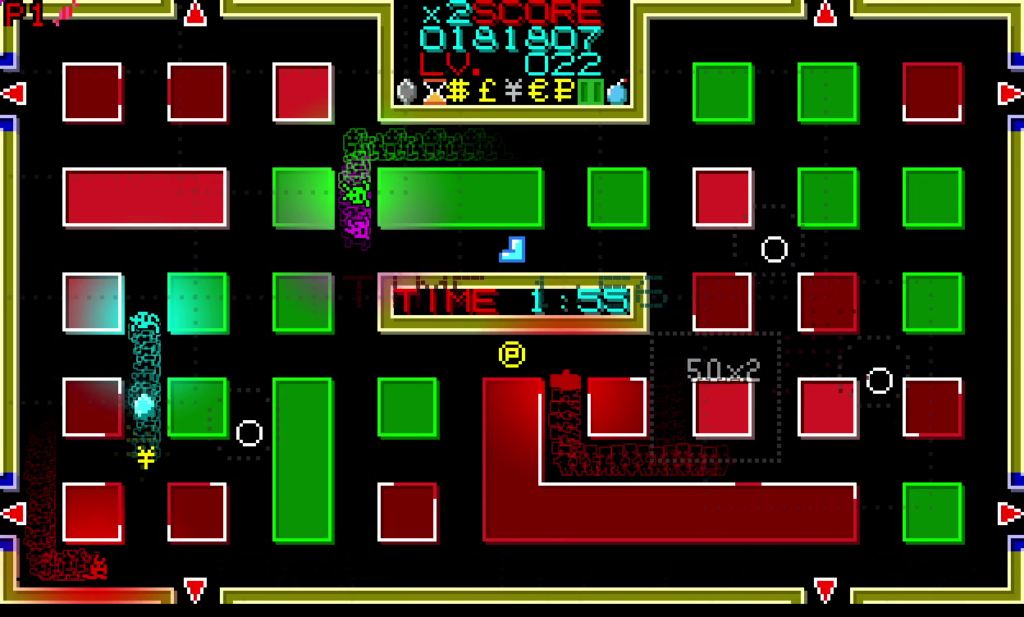
This would be a fine note to end on, but I will dig a little deeper (pun intended), maybe too deep. 3671 marks the most drastic break from the original’s design of all the Heiankyo Alien sequels so far. The 1990 Meldac Heiankyo Alien on Game Boy and Heiankyo Alien NEO also feature high-quality soundtracks but expand on the vague setting that 1979 graphical fidelity could not depict. The 1995 “New Type” Nihon Busson Super Famicom remake does as well, but without the good music.
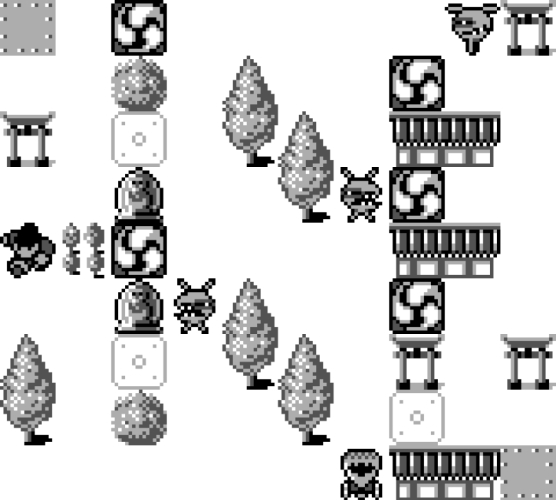
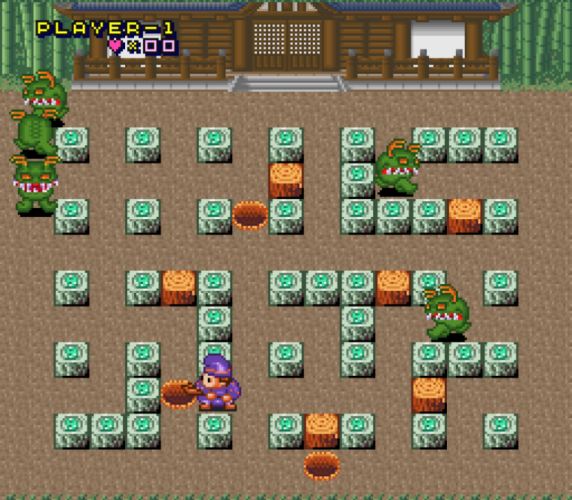
Instead of an abstract maze, the Meldac and Nihon Busson re-imaginings offer sprite art of Heiankyo streets, a player character in period-appropriate clothing, and more menacing alien designs. The packaging of the Meldac Game Boy game is itself a work of art, featuring ukiyo-e-style illustrations of the player character, shovel in hand, and the fearsome aliens more as some yōkai, as though this were a time-honored tale.
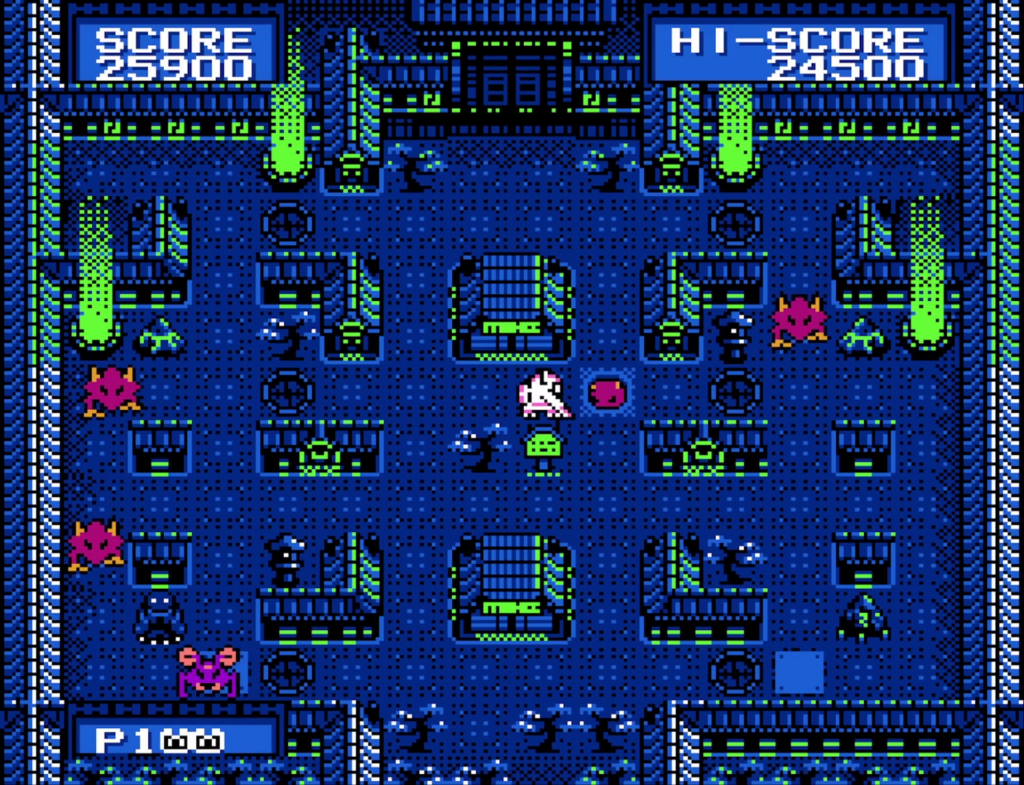
NEO features graphics depicting an armored warrior in a goofy futuristic but recognizably traditionally Japanese “Neo-Kyoto.” (The “character dot designer[s]” are “Mr.DOTMAN” and Hiroshi Ono, while the “illustrator” is Riki.) Structured like a modern video game, these takes on the Heiankyo Alien concept feature distinct levels in discernible environments culminating in an ending. They feature new environmental obstacles, such as tiled squares where the player character cannot dig holes. They abandon arcade abstraction, while still including the original, to lean into the traditional Japanese theme. These sequels, however, fail to deliver the tight, addictive high-speed challenge of 3671, the Meldac Heiankyo Alien frustrating, the New Type Heiankyo Alien dull and too picky about digging spots, and NEO super cool though too slow and simple. I never put half as much time into them as I have into 3671.
Yet beside the delectable charm of these other Heiankyo Aliens, 3671 feels somehow cold and incomplete (and not only because of the missing Idol Version). The sense of narrative or discovery I value in video games is foreign not only to the original Heiankyo Alien but to what was possible in 1979. The gap between what I enjoy about the Meldac or Columbus Circle sequels and what 3671 becomes through faithfulness to the early arcade spirit is the gap between the unique locations and twists and exploration and expansions of the arcade concepts that give a sense of life and whimsy to Ms. Pac-Man: Maze Madness and the tight, flow-inducing void of Pac-Man Championship Edition.
I do feel the thrill of “[tasting] the tremendous uplifting feeling of killing aliens furiously,” yet also I feel saddened with every computer voice saying “Better luck next time” or “You need practice” as the timer reaches 0:00 (no matter how well I perform) to remind me there is no goal, no world to visit, but only numbers. 3671 is not an adventure but a way to achieve a sort of high. What richness there is inheres only in game systems abstracted to the point of, ironically enough, alienation. Not a flaw per se, this difference between 3671 and the more human though quaint sequels speaks to different design philosophies.
More human in their virtual worlds, the other sequels also allow definitive endings, a sense of triumph over the repelled invasion. A player leaves happy. But 3671 stays faithful to the 1979 spirit of futility: no matter how aggressive and skillful the player’s strategy, the policeman is some grunt facing certain death. A player leaves craving something more that is not there. Yet I keep telling myself I’ll play just one more round. 3671 is a video game I turn to when too sad or tired for something richer. This doomed determination must be why the PDF instructions do not claim the goal is to save Heiankyo but merely to “make Aliens scare the hell out.”
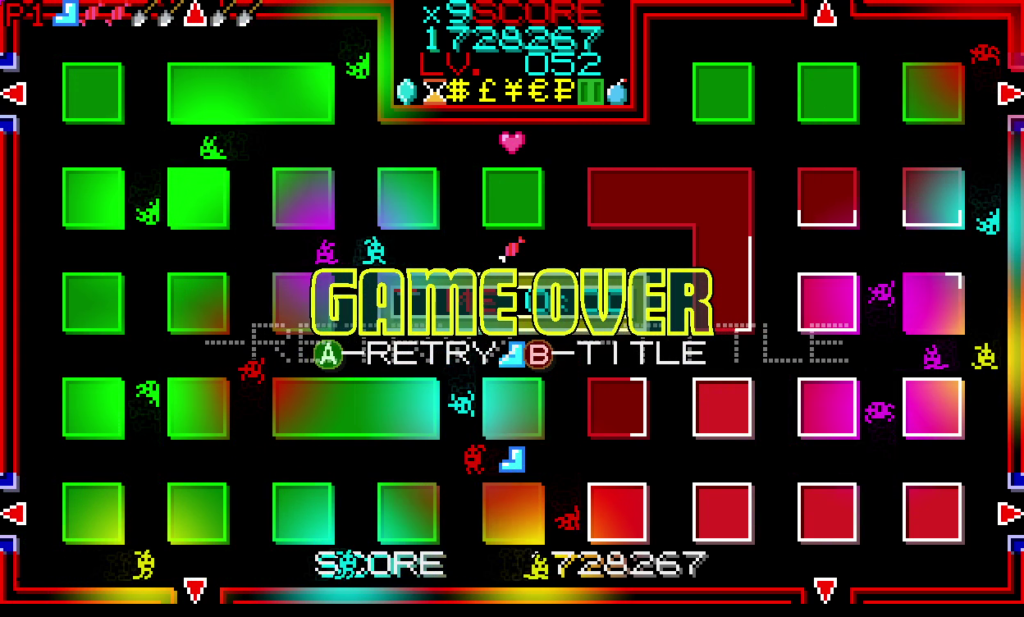
Still, if you dig a high-speed arcade game, don’t let me make you scare the hell out from giving 3671 a try. It’s available on Steam.
Thank you for reading 👋